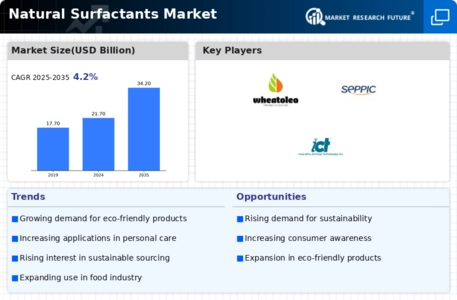Leading market players are investing heavily in research and development in order to expand their product lines, which will help the Natural Surfactants market, grow even more. Market participants are also undertaking a variety of strategic activities to expand their global footprint, with important market developments including new product launches, contractual agreements, mergers and acquisitions, higher investments, and collaboration with other organizations. To expand and survive in a more competitive and rising market climate, Natural Surfactants industry must offer cost-effective items.
Manufacturing locally to minimize operational costs is one of the key business tactics used by manufacturers in the global Natural Surfactants industry to benefit clients and increase the market sector. In recent years, the Natural Surfactants industry has offered some of the most significant advantages to medicine. Major players in the Natural Surfactants market, including BASF SE, Clariant AG, Croda International Plc., WHEATOLEO, The Dow Chemical Company, CECA Arkema Group, SEPPIC, Evonik Industries, and Innovative Chemical Technologies.
Material science is the focus of Dow Inc. (Dow). The Dow Chemical Co., the company's wholly owned subsidiary, conducts business on its behalf (TDCC). Plastics, performance materials, coatings, silicones, and industrial intermediates make up the company's product line. For customers in the packaging, infrastructure, mobility, and consumer care areas, the company offers a variety of goods and services. Several industries, including home and personal care, durable goods, adhesives and sealants, coatings, and food and specialty packaging, use Dow's products. It has activities throughout Africa, the Middle East, Latin America, the Asia-Pacific region, and North America.
The U.S. state of Michigan's Midland serves as the home of Dow. A deal between Dow and Locus Performance Ingredients to distribute Locus PI's portfolio of sophorolipid biosurfactants to the personal care sector was announced in February 2022. The collaboration will bring together Locus PI's experience in fermentation and capacity to create specialized biosurfactant components with Dow's formulation know-how and market reach in the personal care sector.
Specialty chemical firm Evonik Industries AG (Evonik), a division of RAG-Stiftung. Surfactants, polymers, resins, additives, among other things, are included in its product line. Agriculture, alternative energy, paints and coatings, paper and printing, metal and oil products, electrical and electronics, food and animal feed, personal care and cosmetics, pharmaceuticals, plastics and rubber, automotive, and construction are just a few of the industries where the company's products are used. Moreover, it provides engineering, logistics, utilities, and process technology services. Major production facilities for Evonik are located in China, Singapore, Belgium, the U.S., and Germany.
In addition to other places, the corporation also operates in North America, Asia-Pacific, Africa, South America, and Europe. Essen, in Nordrhein-Westfalen, Germany, serves as the headquarters for Evonik. Evonik held a groundbreaking ceremony today to mark the beginning of work on the first commercial rhamnolipid production facility in the world, which is scheduled to open in June 2022. At Slovakia's biotech hotspot of Evonik, the new biosurfactant plant represents a triple-digit million euro investment. This will further solidify the Slovenská upa location as a key biotechnology hub and establish Evonik as a market leader in high-quality, sustainable biosurfactants.



 Source: Secondary Research, Primary Research, Market Research Future Database and Analyst Review
Source: Secondary Research, Primary Research, Market Research Future Database and Analyst Review









